
DAKAR, Senegal — The vibrant atmosphere at the opening of this year’s Dakar Biennale of Contemporary African Art reflected a striking contrast with the serious themes addressed in the artworks of American artists. The showcase featured pieces that delve into the complex history and ongoing legacy of slavery, highlighting the unsettling yet essential conversations around this topic.
This year’s U.S. exhibit presents the work of seven African American artists whose creations thoughtfully explore the implications of slavery, both historically and presently. The Dakar Biennale, known as Dak’Art, is a biennial international event that highlights the flourishing art scene across Africa, created by the Senegalese government in 1989.
During the opening ceremony held in Dakar’s capital, traditional West African attire mingled with modern attire, creating a tapestry of cultural representation. Guests adorned in flowing “boubous” and formal black suits celebrated the occasion, emphasizing the fusion of heritage and modernity.
The theme for this year’s exhibition, titled “The Wake,” features 58 artists from 33 different nations, each interpreting the concept through various lenses such as loss, remembrance, and dislocation. As per Salimata Diop, the artistic director of Dak’Art, the core intention is to interweave past narratives with future possibilities, giving equal weight to both realms.
Significantly, the United States stands as the featured guest nation in this edition of the Biennale. Within the exhibit, African American artists responded to the cultural beliefs of the Lebou people — one of Senegal’s ethnic groups that view the ocean as the eternal domain for spirits after death. The display included innovative representations of an alphabet crafted into the natural curls of African hair, alongside an immersive experience designed to evoke the haunting realities faced by enslaved individuals.
Diana Baird N’Diaye, the curator of the showcase, underscored the pervasive influence of slavery on all Americans. She noted that the artworks don’t merely reflect historical pain but also serve as a hopeful gaze toward the future. “We exist today because our ancestors overcame slavery,” she remarked, emphasizing the resilience of those who came before them and the significance of acknowledging their struggles.
Against a backdrop of shifting regional alliances and the rise of new partnerships with countries such as Russia and China, the Dak’Art exhibition unfolds in a historically rich yet tumultuous context. While many nations in West Africa have grappled with coups and violent extremism in recent years, Senegal has upheld its image as a stable democracy. Nonetheless, tension exists within Senegalese politics as the ruling party prepares for upcoming elections and contemplates its relations with Western powers, albeit without drastic changes thus far.
Khady Diène Gaye, Senegal’s minister of youth, sports, and culture, articulated the importance of the U.S. being the guest of honor, highlighting art as a vital channel for dialogue, peace, and mutual understanding while also serving the purposes of social and economic development. The Dak’Art exhibition is set to continue until December 7, following a delay due to political unrest and funding challenges tied to recent elections.
